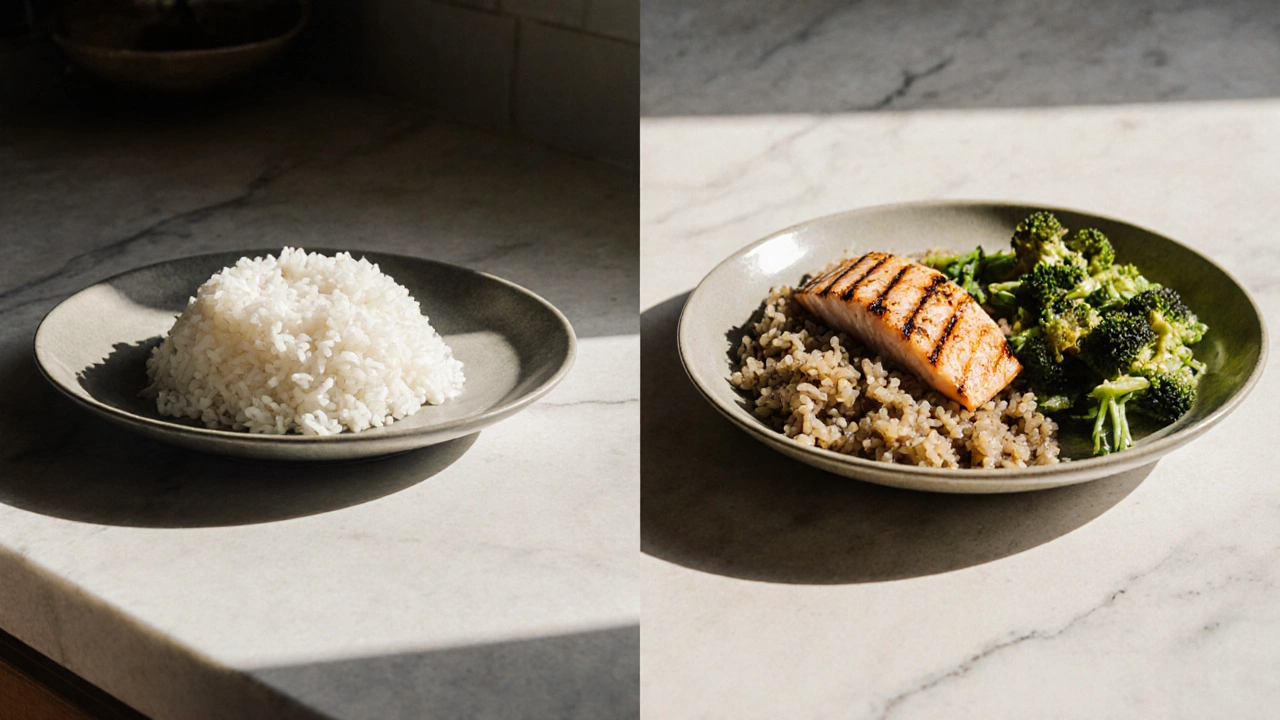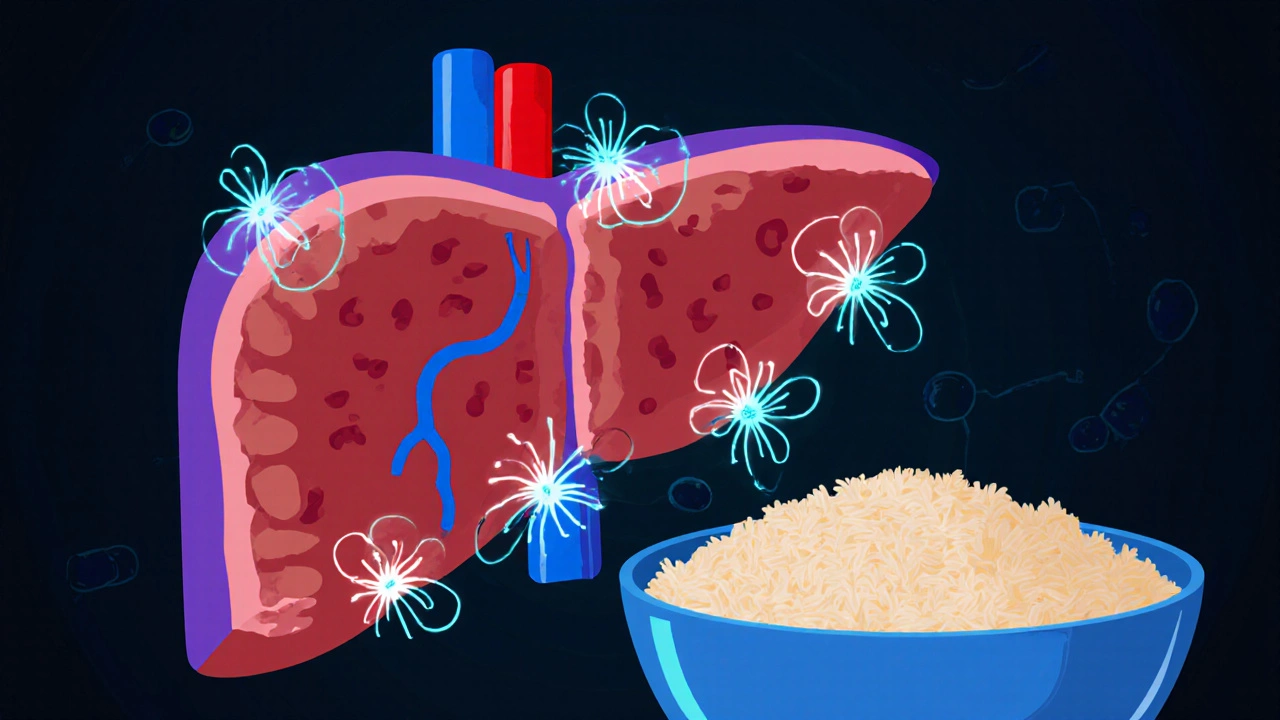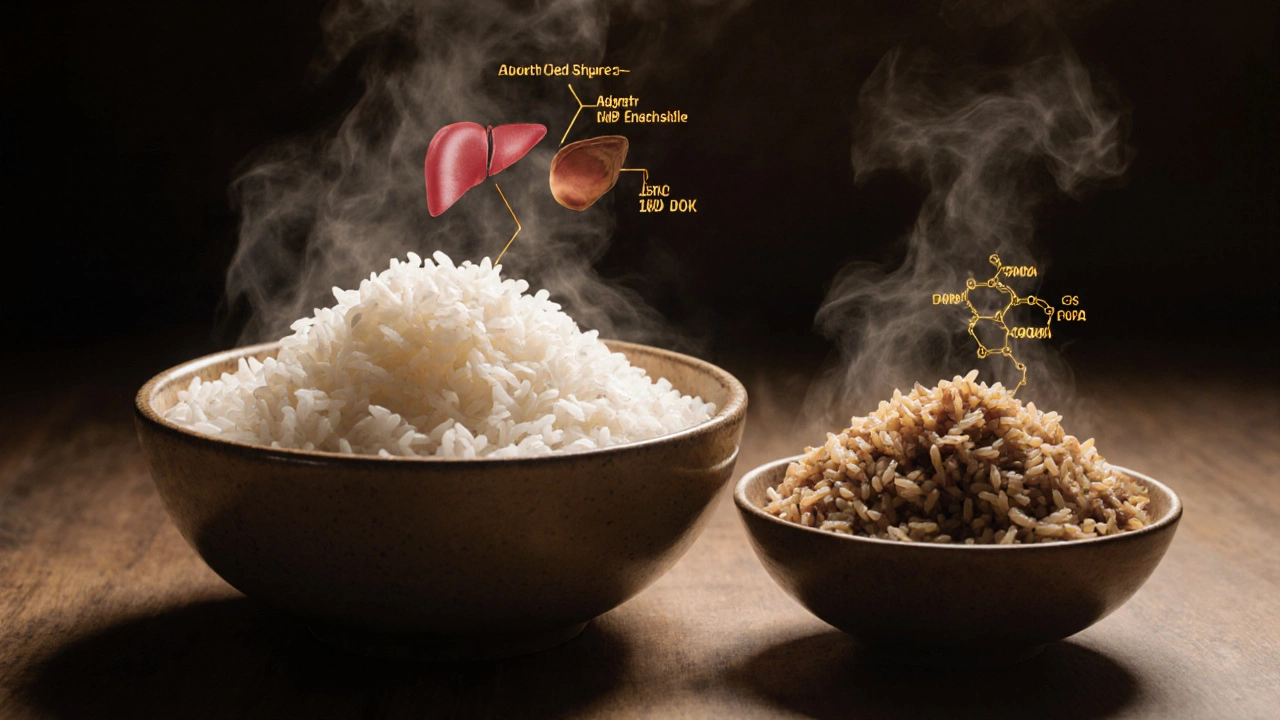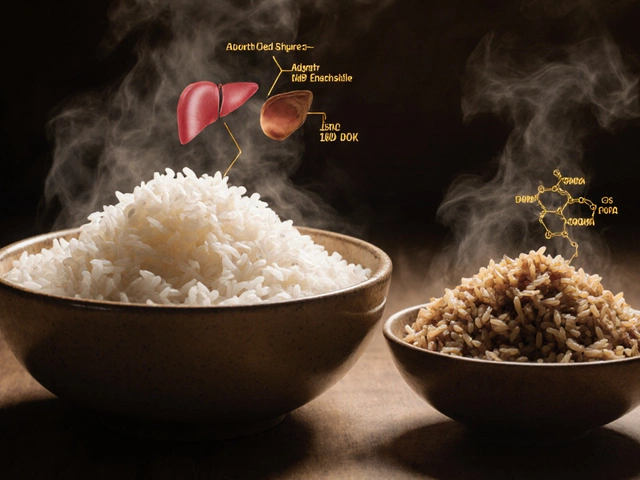Cholesterol Impact Calculator
This calculator uses research from the American Heart Association to estimate how your white rice consumption affects LDL cholesterol levels. Based on the article, eating white rice 5+ times per week can increase LDL by 12% compared to brown rice.
Your Estimated Impact
Recommendation:
White rice is a staple food for over half the world’s population. It’s cheap, filling, and cooks quickly. But if you’re watching your cholesterol, it might be time to rethink how often you eat it. The problem isn’t that white rice contains cholesterol-because it doesn’t. The issue is what it does to your blood sugar and how that triggers changes in your liver that raise bad cholesterol levels.
How white rice affects your blood sugar
White rice is almost pure starch. During processing, the bran and germ are stripped away, leaving only the starchy endosperm. That means it’s digested fast-faster than most breads. When you eat a bowl of white rice, your blood sugar spikes within 30 minutes. Your body responds by releasing a large burst of insulin to pull that sugar out of your bloodstream.
That insulin spike doesn’t just manage sugar. It also tells your liver to start making more triglycerides and LDL cholesterol. Studies from the American Heart Association show that people who eat white rice five or more times a week have 17% higher triglyceride levels and 12% higher LDL cholesterol than those who eat it less than once a week. This isn’t about one meal. It’s about repeated daily stress on your metabolism.
LDL cholesterol and the liver connection
Your liver doesn’t make cholesterol just because you eat it. Most of the cholesterol in your blood is made by your liver, especially when your blood sugar is high. Insulin doesn’t just lower sugar-it also activates enzymes that turn excess glucose into fat. That fat gets packaged into LDL particles, the kind that stick to artery walls and increase heart disease risk.
White rice doesn’t have saturated fat or trans fat. But its rapid digestion mimics the metabolic effects of eating sugar. In fact, researchers at Harvard found that replacing just one serving of white rice per day with brown rice lowered LDL cholesterol by an average of 8% over eight weeks. That’s the same drop you’d see from switching from butter to olive oil.
Why brown rice is a better choice
Brown rice keeps the bran and germ, which means it has fiber, magnesium, and antioxidants. Fiber slows digestion. That means your blood sugar rises slowly, and your insulin doesn’t go into overdrive. Less insulin means less fat production in the liver. Less fat production means fewer LDL particles floating around.
One cup of cooked brown rice has 3.5 grams of fiber. White rice has 0.6 grams. That’s almost six times less. The fiber in brown rice also binds to bile acids in your gut. Your body needs to use cholesterol to make new bile acids, so it pulls cholesterol out of your blood to do it. That’s a natural way to lower circulating LDL.

What about other rice varieties?
Not all rice is the same. Black rice and red rice have even more antioxidants than brown rice. They’re higher in anthocyanins, which studies show help reduce inflammation and improve lipid profiles. Wild rice isn’t technically rice but a grass-it’s higher in protein and fiber than any white rice variety.
Parboiled rice is a middle ground. It’s processed but retains more nutrients than regular white rice. The steaming process before milling pushes some nutrients from the bran into the endosperm. It still raises blood sugar more than brown rice, but less than plain white rice. If you can’t switch to brown rice right away, parboiled is the next best thing.
Portion size matters more than you think
Even if you eat brown rice, overdoing it can still hurt your cholesterol. A study in the Journal of Nutrition found that people who ate three cups of rice per day-whether white or brown-had higher triglycerides than those who ate one cup. The problem isn’t just the type of rice. It’s how much you eat.
Most people serve rice as a side dish, but it often becomes the main event. Try cutting your portion in half and filling the plate with vegetables instead. A plate that’s half vegetables, a quarter lean protein, and a quarter rice (brown or parboiled) keeps blood sugar steady and supports healthy cholesterol levels.

Who should avoid white rice entirely?
If you have metabolic syndrome, prediabetes, or high LDL cholesterol, white rice should be rare, not routine. People with these conditions have livers that are already overworked. Adding fast-digesting carbs like white rice makes it harder for your body to recover.
Even if you’re healthy now, daily white rice can lead to insulin resistance over time. That’s the first step toward type 2 diabetes-and diabetes nearly doubles your risk of heart disease. The American Diabetes Association recommends replacing refined grains like white rice with whole grains as a core strategy for preventing metabolic decline.
Real-world swaps that work
You don’t have to give up rice altogether. Just change how you eat it.
- Swap white rice for quinoa in stir-fries
- Use cauliflower rice for curry bases
- Try barley or farro instead of rice in soups
- Make rice bowls with double the veggies and half the rice
One woman in her 50s, who ate white rice three times a day for decades, switched to brown rice and added a daily walk. In six months, her LDL dropped from 168 to 112. She didn’t change her fat intake. She didn’t take medication. She just changed the grain.
It’s not about guilt-it’s about balance
White rice isn’t poison. In cultures where it’s eaten with vegetables, fish, and fermented foods, cholesterol problems are less common. The problem isn’t rice itself. It’s the modern way we eat it: large portions, alone, with little fiber or protein to slow digestion.
If you love white rice, have it once in a while. But make it the exception, not the rule. Your liver will thank you.
Does white rice contain cholesterol?
No, white rice contains zero cholesterol. The issue isn’t direct cholesterol in the food-it’s how your body responds to the rapid sugar spike it causes. That spike triggers your liver to produce more LDL cholesterol.
Can I eat white rice if I have high cholesterol?
You can, but you should limit it. Eating white rice frequently raises triglycerides and LDL cholesterol over time. If you have high cholesterol, replace most white rice with brown rice, quinoa, or barley. Even small swaps can lower LDL by 8-12% in a few months.
Is brown rice better for cholesterol than white rice?
Yes. Brown rice has fiber, magnesium, and antioxidants that slow digestion and reduce insulin spikes. Studies show switching from white to brown rice lowers LDL cholesterol by 8% and raises HDL (good cholesterol) slightly. The fiber also helps your body remove excess cholesterol through bile.
How much rice should I eat per meal for heart health?
Aim for one cup of cooked rice per meal-no more. That’s about the size of your fist. Fill the rest of your plate with vegetables and lean protein. Eating large portions of any grain, even whole grains, can still raise triglycerides if you’re inactive or insulin resistant.
Does cooking method affect white rice’s impact on cholesterol?
Yes. Cooling cooked white rice for 12 hours turns some starch into resistant starch, which digests slower and causes a smaller blood sugar spike. Reheating it doesn’t destroy this effect. So leftover rice, if cooled properly, is slightly better than freshly cooked. But it’s still not as good as brown rice.


